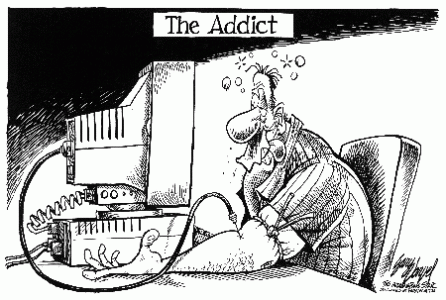Pristinegirl
Well-known member
- MBTI
- ANFP
Internet addiction disorder (IAD) is a maladaptive pattern of Internet use, leading to clinically significant impairment or distress. SO I'm wondering if this is common amongst INFJ's? Apparently 2/3 of populations in developed countries have this.
It is manifested by 3 or more of the following, occurring at any time in the same 12-month period:
1. Tolerance: defined by either a need for markedly more amounts of time on the Internet to achieve satisfaction or markedly diminished effect with continued use of the same amount of time on Internet.
2. Withdrawal: by reducing the amount of time spent on internet after a heavy and prolonged period.
a. Psychomotor agitation
b. Anxiety
c. Obsessive rumination regarding events presently occurring on the Internet
d. Fantasies or dreams about the Internet
e. Involuntary typing movements of the fingers
f. The symptoms cause impairment in social, occupational, or another important area of functioning.
3. Internet: accessed more often or for longer period of time than was intended.
4. Desire to control use: Persistent desire or unsuccessful efforts to cut down or control Internet use.
5. Time spent: A great deal of time is spent in activities related to Internet use, eg buying Internet books, trying out new web browsers, researching Internet vendors, organizing files of downloaded material.
6. Normal activities ignored: Important social, occupational, or recreational activities are given up or reduced because of Internet use.
7. Use continues despite recognition of ill effects: Use continues despite knowledge of having a persistent or recurrent physical, social, occupational, or psychological problem that is likely to have been caused or exacerbated by Internet use
It is manifested by 3 or more of the following, occurring at any time in the same 12-month period:
1. Tolerance: defined by either a need for markedly more amounts of time on the Internet to achieve satisfaction or markedly diminished effect with continued use of the same amount of time on Internet.
2. Withdrawal: by reducing the amount of time spent on internet after a heavy and prolonged period.
a. Psychomotor agitation
b. Anxiety
c. Obsessive rumination regarding events presently occurring on the Internet
d. Fantasies or dreams about the Internet
e. Involuntary typing movements of the fingers
f. The symptoms cause impairment in social, occupational, or another important area of functioning.
3. Internet: accessed more often or for longer period of time than was intended.
4. Desire to control use: Persistent desire or unsuccessful efforts to cut down or control Internet use.
5. Time spent: A great deal of time is spent in activities related to Internet use, eg buying Internet books, trying out new web browsers, researching Internet vendors, organizing files of downloaded material.
6. Normal activities ignored: Important social, occupational, or recreational activities are given up or reduced because of Internet use.
7. Use continues despite recognition of ill effects: Use continues despite knowledge of having a persistent or recurrent physical, social, occupational, or psychological problem that is likely to have been caused or exacerbated by Internet use


